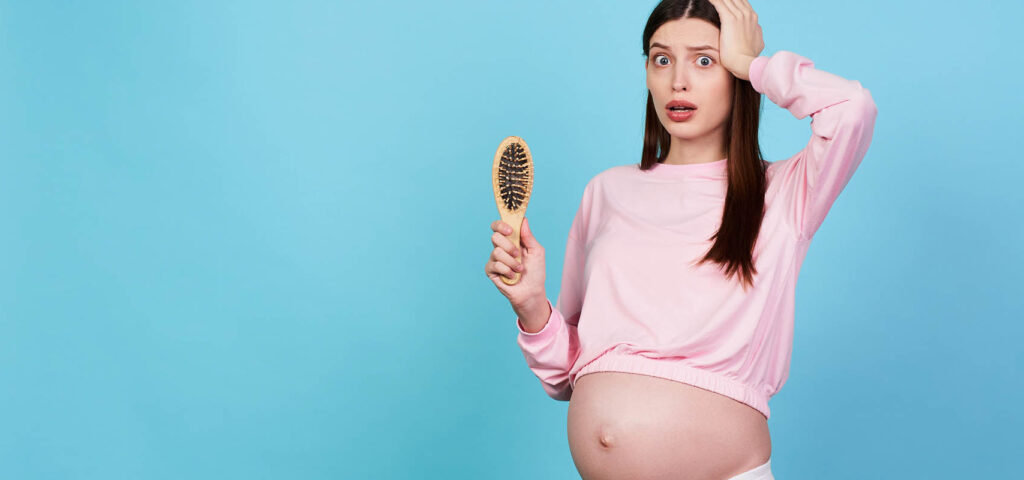Increased hair loss after pregnancy can affect up to 90% of women who have recently given birth. It’s a condition that causes a tremendous amount of anxiety. Most often it passes fairly quickly, but sometimes it lasts long enough that visible defects begin to appear in the hairstyle. This is related to the normalization of the hormonal situation in the body and natural – you can then lose up to 30% of all hair. Learn how to deal with hair loss after pregnancy.
Causes of hair loss after pregnancy
Hair loss after pregnancy is sometimes called postpartum alopecia and is a type of telogen alopecia. It can involve only the area of the curves or occur in a scattered manner over the entire head. During pregnancy, estrogen levels in a woman’s body increase significantly. It is this hormone that is responsible for many of the important changes in the body that must take place for the baby to be born. However, it also has to do with making hair stronger, thicker and more powerful. When estrogen levels drop dramatically after pregnancy, strands become weakened and fall out. This is a sign that hormone levels are returning to normal, but unfortunately it results in a slightly thinning hairstyle. Negative feelings are compounded by the fact that the hair looked better than usual during pregnancy.
Some researchers link the issues of hair loss after pregnancy to genetic factors. This is because it has been observed that some women tend to lose them more than others. The problem of hair loss can be further exacerbated by a large dose of stress and sleep deprivation caused by the arrival of a young person into the world, but also thyroid problems, postpartum depression, anemia, deficiencies and improper eating habits. Check out other causes of hair loss.
How long does increased hair loss after pregnancy last?
How long the condition of increased hair loss lasts is largely dependent on individual factors. Most often it passes fairly quickly, as in about 3 months, but sometimes it drags on even up to six months or a year. If baldness persists for more than 9 months, you can go for a checkup, in which the level of thyroid hormones will be determined – in a situation where health problems arise, quick detection will help control the situation in time. However, one must be prepared for the fact that it takes time to return to the standard concentration of certain compounds in the blood.

Hormone concentration in the body and the life cycle of hair
It may seem comforting to know that the only hair that falls out in the post-pregnancy period is the hair that would have fallen out over the 9-month period anyway. However, they remained in place longer precisely because of the increased concentration of estrogen in the body. This is related to the natural life cycle of hair, which consists of three phases:
- anagen – the growth phase. The vast majority, as up to 90% of the hair on the head is in this phase. Its duration is from 2 to 6 years.
- catagen – or transition phase. It involves inhibiting hair growth and preparing for hair loss. It lasts from a few days to a maximum of a few weeks.
- Telogen – the so-called. A resting phase, lasting 2-4 months. During this period, the root of the hair shrinks, and the hair falls out when the hair is washed or combed. If this does not happen, the old hair will be pushed out by the forming stalk of new hair.
Since estrogen has a positive effect on hair and causes it to strengthen, the duration of the anagen phase is prolonged. As a result, hair does not fall out naturally at the time it would have come in the case of standard hormone levels in the body. As the baby comes into the world and the breastfeeding period begins, prolactin levels also increase, which in turn has a negative effect on hair.
Later, the body’s hormonal situation returns to normal, and this results in the loss of hair that remained on the head due to the pregnancy hormonal storm. This occurs in such an abrupt and noticeable way because normally each hair has its own cycle and enters different phases at different times – in this particular case, these moments overlap for a large number of hairs. Also read: The effect of hormones on hair loss. What hormones to test?
When is postpartum baldness a cause for concern?
Under normal conditions, a healthy person loses up to about 100 hairs a day. For post-pregnancy women, the figure rises to 150 hairs per day. However, since this is a natural, physiological condition, the hair that falls out is replaced by new hair. In a situation where baldness has persisted for too long or we are excessively concerned about the condition, it is best to go to a trichologist for advice. A visit is also necessary when other scalp symptoms appear – seborrhea, dandruff, itching or visible inflammatory foci.
The doctor will take a history, perform the necessary tests, and then determine whether hair loss after pregnancy in a particular case is within the normal range. If not – he will certainly recommend the use of appropriate remedies or treatments and choose the right hair care products for problem hair. Proper grooming habits are often almost as important as in-office therapy, so they should not be underestimated.
What for hair loss after pregnancy?
If the patient has been diagnosed with the condition, the basis for eliminating the problem of excessive hair loss will be to remove the cause. In a situation where it is a physiological condition, the severity of which worries the patient, supplements and preparations administered topically are used, but only after consultation with a doctor – as not all of them can be used during breastfeeding. In addition to this, treatments from a trichologist or cosmetologist prove to be very helpful. Which of them can bring satisfactory results in postpartum baldness?
Needle mesotherapy
Needle mesotherapy involves injecting nourishing cocktails deep into the scalp. Each time, the specialist, based on an interview with the patient, selects the appropriate preparation, which should bring the desired results. Since the needles used for injection are very small and the punctures are not made too deeply, the procedure is painless.
Mesotherapy can thicken hair, nourish it and make it grow stronger and thicker. It reduces the phenomenon of premature hair loss by strengthening the hair. It is also used for other types of baldness – not just postpartum baldness. In most patients, it helps eliminate troublesome scalp symptoms. There are no contraindications to carrying it out after pregnancy.
Carboxytherapy
Carboxytherapy can thoroughly nourish the skin and reduce hair loss. It involves injecting medical carbon dioxide deep into the skin. Thus, this one is stimulated to improve blood flow, create new blood vessels and stimulate hair follicles to work. In this way, we can reduce baldness, thicken hair and positively affect the condition of the scalp, which will result in healthier, thicker and shinier hair. The procedure is neither painful nor invasive, and what’s more, it can be combined with, for example, mesotherapy or platelet-rich plasma without fear. However, we perform it after the breastfeeding stage is over.
Oxygen infusion
Oxygen infusion involves the injection of high-molecular-weight oxygen under high pressure into the deep layers of the skin. Depending on the choice of pressure, problems such as excessive hair loss, seborrhea, dandruff, folliculitis or dermatoses can be resolved. Thus, it is quite a versatile treatment to deal with more than just baldness. After carrying it out, we get better oxygenation and blood supply to the scalp. Hair becomes stronger, less prone to shedding and thicker. The procedure is painless and non-invasive. During it, the patient only feels the cooling of the skin. Besides, oxygen infusion is used prophylactically and to strengthen healthy hair.
Platelet-rich plasma treatments
Platelet-rich plasma treatments are a great choice for people who tend to have allergic reactions to cosmetic preparations. Plasma is made from venous blood taken from the patient before the procedure. This one must be properly centrifuged, and only then administered to the areas affected by baldness. This reduces the risk of allergic symptoms to practically zero.
Plasma helps reduce hair loss and visibly strengthen hair. They grow back faster, are nourished, and scalp problems disappear. Like the other treatments listed here, those using plasma are also used for other types of baldness. The effectiveness of plasma treatments ranks at a very satisfactory level. They require no convalescence, are quick to carry out and comfortable for the patient. Not surprisingly, then, plasma has revolutionized the approach to hair loss therapy.
Platelet-rich Plasma for Hair (PRP)
Topically applied drugs and orally applied drugs
After the end of the lactation period, therapy with topically applied medications, scrubs and trichological rubs on the scalp, as well as orally applied preparations, can be started without any obstacles. Dr CYJ Filler peptide therapies have been gaining a lot of popularity lately, which are great for dealing with hair loss. Other frequently used topical preparations for alopecia include minoxidil. It must not be used during breastfeeding, as it crosses into breast milk and can harm the baby. However, it works great in the treatment of baldness and allows for large hair growths in a short period of time.
These are extremely effective methods that we mostly use when previous treatment efforts have failed. This is a slightly more complex baldness therapy, which is constructed by a doctor after a thorough analysis of a particular case. When a patient is under the care of a trichologist, she need not fear that postpartum alopecia will leave her with bald patches on her head. There are no situations in which nothing can be done, and there are many options for action and treatment of excessive hair loss.





